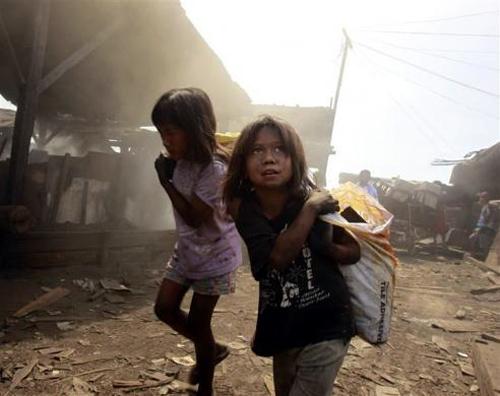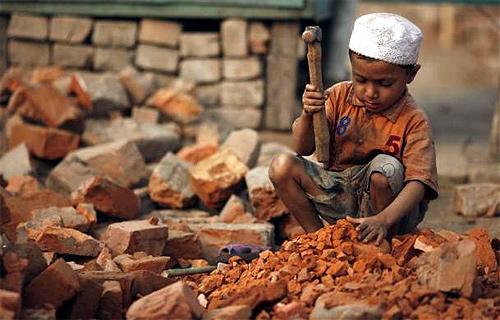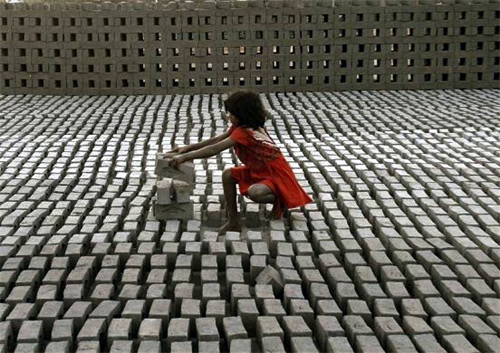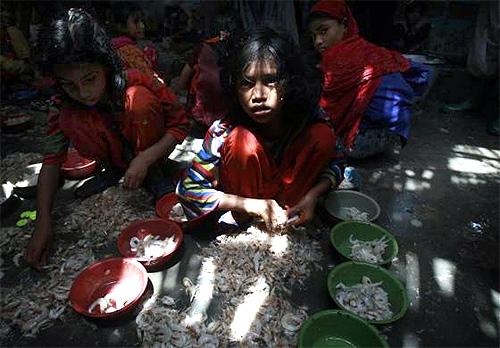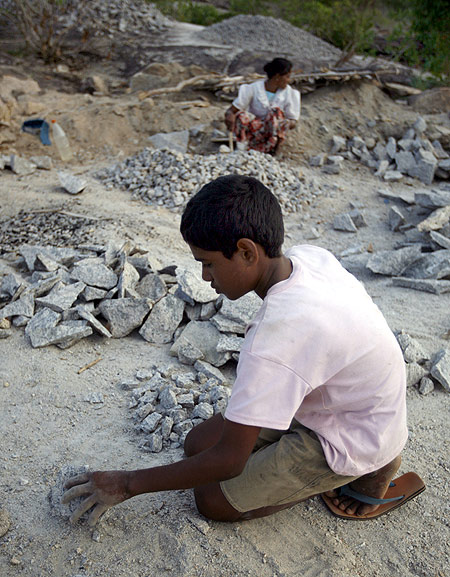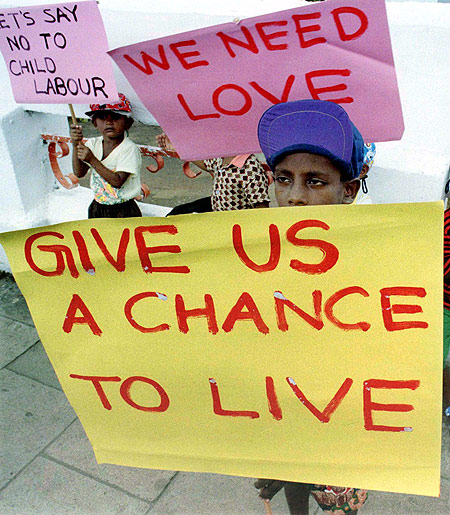 | « Back to article | Print this article |
Worst forms of child labour in Asia
While South Asia is still lagging in curbing child labour, South American countries like Brazil and Chile have made significant strides.
From 33 countries of the Asia and Pacific, 12 countries have achieved moderate advancement, seven countries minimal, eight no advancement whatsoever while six were not even assessed, according to the latest findings on the 'Worst Forms of Child Labour' report, mandated by the Trade and Development Act of 2000.
The report analyses on an annual basis the worst forms of child labour in 144 foreign countries and territories of the world.
Click NEXT to read more...
Worst forms of child labour in Asia
While announcing the release of the three revised reports on global child labour and forced labour, prepared by the department's Bureau of International Labour Affairs, US Secretary of Labour Hilda L. Solis said, "These reports remind us of what happens to the most vulnerable members of society when poverty and labour exploitation unite. The information in these reports is a vital tool in the effort to stop this abuse and can have an enormous impact in the hands of those who want to join efforts to end these labour practices."
ILAB, foreign governments and non-government organizations use these reports to inform policies and develop programs targeting vulnerable children and their families.
In the latest report, child labour situation during 2011 in Afghanistan, India, Pakistan, Bangladesh and Sri Lanka of South Asia were evaluated.
Take a look at the alarming situation of child labour across Asia...
Click NEXT to read more...
Worst forms of child labour in Asia
Afghanistan
According to the report, Afghanistan made minimal advancement in efforts to eliminate the worst forms of child labour although the government of Afghanistan and the UN signed an agreement in which the government pledged to prevent the recruitment of minors into the national armed forces.
The report acknowledged Afghan government's training to the Afghan National Police (ANP) on this policy and investigated some cases of child recruitment.
However, despite this policy and these efforts, children were still recruited and used for military purposes by non-state groups as well as by the Afghan National Security Forces (ANSF), including the ANP.
Children in Afghanistan remain engaged in other worst forms of child labour, including forced labour in the production of bricks and dangerous work in agriculture.
Click NEXT to read more...
Worst forms of child labour in Asia
The report mentioned that children working in agriculture may apply pesticides, use dangerous machinery and tools and transport heavy loads. Also there is limited evidence that children also raise livestock or shepherd animals, risking injury from animals.
A study found that some children raising livestock may be physically abused and sexually harassed by animal owners.
The report also stated that Non-State armed groups, such as the Haqqani Network, Hezb-i-Islami, Tora Bora Front, Jamat Sunat al-Dawa Salaia and the Taliban, recruit child soldiers. The Taliban reportedly uses children as suicide bombers.
Armed groups also reportedly use children, especially boys, in commercial sexual exploitation. These children are required to dance for them and are often sexually exploited.
The report stated that Afghan children are trafficked internally for forced labour, including debt bondage, in the brick industry, forced begging, sexual exploitation, child soldiering and domestic service as well work in the carpet industry.
Click NEXT to read more...
Worst forms of child labour in Asia
Bangladesh
The report lauded Bangladesh's moderate advancement in 2011 towards eliminating worst forms of child labour by passing the Human Trafficking Deterrence and Suppression Act 2012 which makes trafficking (including labour trafficking) a capital offence.
It has developed and fully funded a Child Labour Monitoring Information System to manage child labour related data and began implementation of a $9 million child labour project.
Click NEXT to read more...
Worst forms of child labour in Asia
However, legal protections regarding child labour are still limited and the capacity to enforce child labour laws remains weak. Bangladesh maintains a low compulsory education age.
Children in Bangladesh are engaged in the worst forms of child labour, primarily in dangerous activities in agriculture and domestic service. Children are also often found in professions like welding, carpentry, rickshaw pulling and automobile repair.
Click NEXT to read more...
Worst forms of child labour in Asia
India
India also moderately advanced in efforts to eliminate the worst forms of child labour, the report states.
The Indian government created a new office to monitor bonded labour and child labour cases and established a new anti-trafficking unit responsible for arresting child traffickers.
India also increased funding to the National Child Labour Project (NCLP) and provided access to health insurance for workers in the informal economy whose children are among the most vulnerable to exploitative child labour.
However, basic legal protections still remain elusive as India lacks a minimum age for work and fails to shield young people ages 14 to 17 from hazardous work, particularly in dangerous activities in agriculture and the manufacturing of goods in the informal economy.
Click NEXT to read more...
Worst forms of child labour in Asia
These include carrying heavy loads, applying harmful pesticides, quarrying sandstone and other materials, breaking stones, polishing gems etc.
The report stated that children may also be subject to bonded labor. It mentioned "Service industries that employ children include hotels, food service and tourism where they are vulnerable to physical violence, mental trauma and sexual abuse."
Furthermore, the report quoted federal police statements that an estimated 1.2 million children are engaged in prostitution in India.
Others are "recruited to serve as soldiers by armed opposition groups in zones where armed conflict is occurring, such as by the Naxalites in Chhattisgarh."
Click NEXT to read more...
Worst forms of child labour in Asia
Pakistan
The report stated that in 2011, Pakistan made no advancement in efforts to eliminate the worst forms of child labour although the Pak government continued to implement programs to address the problem.
However it continued to lack sufficient legal protections for working children as there is still no minimum age for work and the minimum age for hazardous work is 4 years below the international standard age of 18. Enforcement efforts are still weak.
Efforts to combat exploitative child labour were complicated in 2011 when federal-level agencies charged with coordinating the national response to the worst forms of child labour were dissolved during a process of dispersing many government functions to the provinces.
Click NEXT to read more...
Worst forms of child labour in Asia
Children continue to engage in the worst forms of child labour in dangerous forms of agriculture and are subject to bonded labour often in brick making, carpet weaving, agriculture, fish raising and coal mining among others.
The report mentioned that children also work in hazardous manufacturing activities, especially in industries, where they are susceptible to industrial accidents. "Children who produce glass bangles are exposed to high temperatures and toxic chemicals and suffer from severe joint pain and lung problems."
"Children working with power looms suffer respiratory disease, work long hours, and face physical and sexual abuse" while in the carpet weaving industry, "children also work long hours and are vulnerable to physical and sexual abuse."
Child trafficking is still rampant in Pakistan where children are "kidnapped, rented or sold for work in agriculture, domestic service, prostitution or begging."
Click NEXT to read more...
Worst forms of child labour in Asia
Sri Lanka
Sri Lanka has minimally advanced at eliminating the worst forms of child labour last year, according to the report.
It adopted a list of 51 hazardous occupations and/or working conditions prohibited to children. However, research found little evidence of government efforts to prosecute those responsible for violating laws regarding prohibition of the use of child soldiers.
Click NEXT to read more...
Worst forms of child labour in Asia
The worst forms of child labour continued to exist in manufacturing and dangerous forms of agriculture.
While some children are engaged in domestic service, children are exploited into prostitution in coastal areas as part of sex tourism.
The report described, "Reports indicate that some children working in agriculture, including those younger than age 12, have been forced to work in the fireworks and fishing industries."
Although "most children in Sri Lanka have access to basic education", "both the two-decade-long civil conflict and the 2004 tsunami devastated parts of the country, creating major educational disparities in the affected areas."

